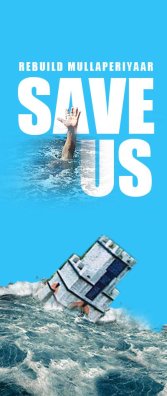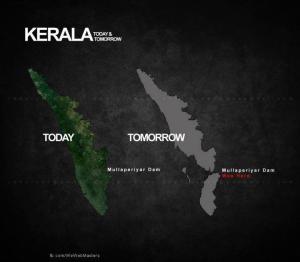 “Why is TamilNadu government opposing a new mullaperiyar dam? Who will be take the responsible for the life of millions of people? There were 20 small earthquake reported in after June 2011 from the area!”
“Why is TamilNadu government opposing a new mullaperiyar dam? Who will be take the responsible for the life of millions of people? There were 20 small earthquake reported in after June 2011 from the area!”
Mullaperiyar the oldest gravity dam build on 1896 is still running even after its expiry date of 50 years, means 63 extra years, now the dam is on the verge of explosion, If that happens it will be the biggest tragedy in the World history, 45 lakh people in middle Kerala will flow down to Arabian sea within 3 mins, Since our leaders are not aware of this danger, be ready to face this Water Bomb which will finish God’s Own Country forever.
Kerala’s Stance: Kerala did not object giving water to Tamil Nadu. Their main cause of objection is the dams safety as it is as old as 110 years. Increasing the level would add more pressure to be handled by already leaking dam. No masonry dam may survive for 999 years so a new dam may replace the existing one in near future.
Tamil Nadu’s Stance: The State want that the 2006 order of Supreme court be implemented so as to increase the water level to 142 feet (43 m).
Mullapperiyar dam is located on the borders of Kerala and Tamil Nadu, exactly in the district of Idukki. The Mullapperiyar (Mulla Periyar) dam is one of the oldest dams in the World. We are talking of safety of the 116-year-old dam when the average life span of well designed and well built dams is generally considered to be about 50 to 60 years by International experts. The issue is that the dam is located on a seismically sensitive area and even an average magnitude tremor can lead to collapsing of the dam. If any disaster strikes, lakhs of people in four districts, Idukki, Ernakulam, Kottayam and Alappuzha will be wiped out. Dam 999 is a Warner Bros Hollywood movie directed by Sohan Roy from Kerala pointing out the issue and possible disaster.
The safety issues relating to Mullapperiyar are heavily interlinked with the safety of the dams of the Idukki project downstream. The level of risk associated with a dam is a function of probability as well as consequences of dam failure. The fact that the failure of the Mullapperiyar dam could lead to failure of the Idukki dam increases the magnitude of the risk associated with the continued use of the Mullapperiyar dam. The probability of a dam failure depends on many factors such as spillway capacity, seismic resistance, nature of foundation, quality of design and construction, monitoring and maintenance and a host of human factors.* Idukki has some weak points in almost all these respects.
The Supreme Court in 2006 ruled that the dam was safe enough to increase the storage level by six feet from 136 to 142 ft, but in a subsequent ruling asked the two States to settle the differences through discussions in an amicable manner. Strong demands were aired by all the political parties in Tamil Nadu that Kerala must abide by the earlier Supreme Court ruling about increasing the storage level of the dam. The plea of the Kerala government all through was that raising the storage level of this dam would be a major security threat to the lives and property of the people in three heavily populated districts of the State and to the fauna in Periyar National Park due to increased flooding.
Given the size of the Idukki, the extent of the devastation that could result from failure of Idukki dam is unimaginable. Idukki’s reservoir capacity is about  74400 million cubic feet of water with a weight of more than 2100 million tones. The expert committee set up by the State Government to study the Mullapperiyar issues has stated that failure of Idukki dams would lead to inundation of more than three districts of Kerala. This presents a frightening picture. The problem is compounded by the fact that hardly any up-to-date early warnings systems, emergency action plans including an evacuation plan exists in the case of both Idukki and Mullapperiyar. Evacuation of people in the event of a dam break from three highly populated districts is practically impossible. Moreover, no dependable dam break inundation study is available to determine the zones to be evacuated.
74400 million cubic feet of water with a weight of more than 2100 million tones. The expert committee set up by the State Government to study the Mullapperiyar issues has stated that failure of Idukki dams would lead to inundation of more than three districts of Kerala. This presents a frightening picture. The problem is compounded by the fact that hardly any up-to-date early warnings systems, emergency action plans including an evacuation plan exists in the case of both Idukki and Mullapperiyar. Evacuation of people in the event of a dam break from three highly populated districts is practically impossible. Moreover, no dependable dam break inundation study is available to determine the zones to be evacuated.
Apart from maintenance, monitoring is an important aspect of keeping a dam safe. The Central Water Commission had suggested installation of a definite pattern of instrumentation at Mullapperiyar to monitor the condition of the dam. Though Tamil Nadu did install some instruments, no measurements had been made available to Kerala. Though the Kerala Government suggested joint monitoring, Tamil Nadu has not agreed to this. In fact, Tamil Nadu engineers have told the technical committee of Kerala that it had not been successful in implementing the necessary instrumentation of the dam. There is apparently no instrumentation in the old portion of the dam. In the backing concrete portion, built as part of the strengthening works, uplift pressure cells, strain meters, joint meters and thermometers have been provided. These were said to have been installed in 1984. However, Tamil Nadu has either not done systematic monitoring of the dam so far or is hiding the data from Kerala. An old dam left without any monitoring itself is a serious matter. Moreover, no instrumentation like piezometres, inclinometers, extensometers’ and gauging weirs are in place to monitor the foundation.
 To put the situation in the right perspective, it must be noted here that one of the oldest serving dams is the 75-miles arch dam of Australia constructed in 1880. However, such long serving dams are exceptions. There is a limit to the number of years one can keep dams in service through maintenance and strengthening measures. One day, it has to be rebuilt, or the dam will give way. Visionary leaders should anticipate this and act accordingly, though that may be difficult course of action for a popular Government in Tamil Nadu under the present circumstances. The problem with Mullapperiyar is that there is no alternate site for construction of a new dam (unless Tamil Nadu/Kerala is prepared to construct a wider dam downstream at a high cost). So, disruption of water supply is bound to occur if the existing dam is demolished and reconstructed. The leaders should prepare the people to go without water for irrigation for some years, if no other alternatives could be found. Kerala cannot be giving water to Tamil Nadu at grave risk to its own population.
To put the situation in the right perspective, it must be noted here that one of the oldest serving dams is the 75-miles arch dam of Australia constructed in 1880. However, such long serving dams are exceptions. There is a limit to the number of years one can keep dams in service through maintenance and strengthening measures. One day, it has to be rebuilt, or the dam will give way. Visionary leaders should anticipate this and act accordingly, though that may be difficult course of action for a popular Government in Tamil Nadu under the present circumstances. The problem with Mullapperiyar is that there is no alternate site for construction of a new dam (unless Tamil Nadu/Kerala is prepared to construct a wider dam downstream at a high cost). So, disruption of water supply is bound to occur if the existing dam is demolished and reconstructed. The leaders should prepare the people to go without water for irrigation for some years, if no other alternatives could be found. Kerala cannot be giving water to Tamil Nadu at grave risk to its own population.
